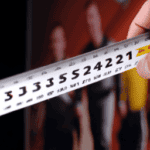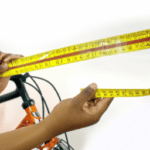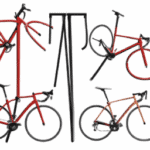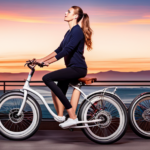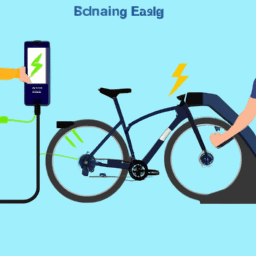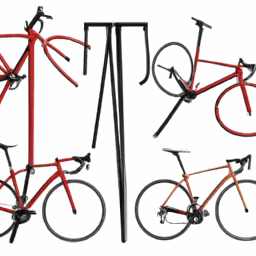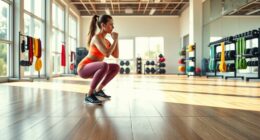Selecting the appropriate bicycle size for a woman who stands at 5’2 requires attention to several crucial elements. Having recently been on the quest for a new bicycle myself, I can confirm the significance of ensuring the bike is the right fit. A poorly fitting bicycle can cause discomfort during rides, and it may also cause pain and injuries if used for an extended period.
In this article, I will share some tips and tricks for finding the right size bike for your needs. The first thing to consider when shopping for a bike is your riding needs. Do you plan on using your bike primarily for commuting, leisurely rides, or more intense workouts? This will help you determine the type of bike you need and the size that will be most comfortable for you.
Once you have an idea of the type of bike you need, you can move on to measuring your inseam length, arm length, and torso length to find the right fit. And, if you’re not sure where to start, consulting with a professional fitter or bike shop expert can be incredibly helpful.
With these tips in mind, let’s dive into the specifics of finding the right size bike for a 5’2 woman.
Key Takeaways
- Measuring inseam length is important for determining appropriate frame size for a 5’2 woman.
- Consulting with a professional fitter or bike shop expert can help make necessary adjustments for individual needs and goals.
- Different types of bikes are designed for different types of riding, so it’s important to consider riding needs and preferences.
- Investing in appropriate clothing and safety gear, such as padded shorts, proper footwear, and a helmet, can enhance comfort and prevent injuries during rides.
Consider Your Riding Needs
Consider your riding needs.
If you’re planning to ride for leisure or commute, you’ll want to think about what size bicycle fits your 5’2 frame best.
One important factor to consider is the type of riding you’ll be doing. If you’ll be mostly riding on paved roads in an urban setting, you may want a bike designed for urban riding. These bikes typically have thinner tires, a lighter frame, and are designed for comfort rather than speed.
On the other hand, if you’ll be doing more off-road riding or tackling mountainous terrain, a mountain bike may be a better fit. These bikes typically have wider tires, a heavier frame, and are designed for durability and stability on rough terrain.
Another factor to consider is whether you prioritize comfort or speed. If you’re looking for a more comfortable ride, you may want to opt for a bike with a more upright riding position, such as a cruiser or hybrid bike. These bikes have a more relaxed geometry and are designed for comfort over speed.
However, if you’re looking to go faster and cover more ground, a road bike or a more performance-oriented hybrid bike may be a better fit. These bikes have a more aggressive geometry and are designed for speed and efficiency.
Once you’ve considered your riding needs, the next step is to measure your inseam length to determine the appropriate frame size for your height.
Measure Your Inseam Length
To get the right fit for a bicycle, measuring your inseam length is crucial. This measurement will help determine the appropriate frame size for your height.
To measure your inseam, you’ll need a tape measure and a book. Stand barefoot against a wall with your feet shoulder-width apart. Place the book between your legs, with one end touching the wall. Make sure the book is pressed firmly against your crotch. Mark the top of the book where it meets the wall, and then measure the distance from the mark to the floor. This measurement is your inseam length.
Choosing appropriate clothing for cycling is also important, as it can affect your comfort and performance. Clothing that is too loose or too tight can cause discomfort or restrict movement. Additionally, stretching before a ride can help prevent injury and increase flexibility. Benefits of stretching include improved circulation, increased range of motion, and reduced muscle soreness.
With a proper fit and appropriate clothing, you can enjoy a comfortable and safe ride. Now, let’s move on to measuring your arm length.
Measure Your Arm Length
Measuring your arm length is a breeze. All you need is a friend and a tape measure. It’s important to measure your arm length because it affects your bike fit. The proper arm position on the bike is crucial for comfort and performance. If your arms are too stretched out, it can cause strain on your shoulders and neck. On the other hand, if your arms are too close to your body, it can limit your breathing and cause discomfort in your wrists and hands.
To measure your arm length, stand up straight with your arms relaxed at your sides. Ask your friend to measure from the top of your shoulder to the middle of your palm. This measurement will help determine the appropriate bike size and handlebar width for your body type. Keep in mind that different frame geometries and handlebar styles may also affect your arm position on the bike.
Now that you’ve measured your inseam and arm length, the next step is to measure your torso length. This will give you a complete understanding of your body proportions and help you choose the perfect bike size.
Measure Your Torso Length
Now that you’ve measured your inseam and arm length, it’s important to also measure your torso length to ensure the perfect fit on your bike. Proper posture on a bicycle is key to preventing injuries and discomfort during long rides.
Measuring your torso length will help you determine the appropriate frame size for your body type. In addition, clothing options and footwear play a significant role in ensuring your comfort and safety while biking.
Wearing the appropriate attire, such as padded shorts and breathable clothing, can alleviate discomfort during rides. Likewise, proper footwear can provide the necessary support and prevent injuries. Don’t forget to also invest in safety gear, such as a helmet and reflective clothing, for added protection.
With this in mind, consulting with a professional fitter or bike shop expert can further assist you in finding the perfect bicycle for your needs.
Consult with a Professional Fitter or Bike Shop Expert
If you want to ensure a comfortable and safe biking experience, it’s worth consulting with a professional fitter or bike shop expert. Bike fit benefits go beyond just finding the right size of bike.
A proper bike fit can help prevent injuries, increase efficiency, and improve overall performance. When finding the right expert, make sure they have experience fitting bikes for individuals with similar body types and biking goals as yourself.
Look for someone who takes the time to assess your individual needs and makes adjustments accordingly. Additionally, don’t be afraid to ask questions and communicate any discomfort or issues you may be experiencing during the fitting process.
With the right expert and a proper bike fit, you’ll be able to enjoy a comfortable and efficient biking experience.
Frequently Asked Questions
How often should I get my bicycle tuned up?
Getting a bicycle tuned up is like getting a car serviced. Frequency recommendations vary depending on how often you ride, but a general rule is to do it every 6 months. DIY tips include cleaning the chain, checking tire pressure, and inspecting brakes and gears.
What type of pedals should I use for a road bike?
When it comes to road biking, there are two main types of pedals: clipless and flat. Clipless pedals offer more efficiency and power transfer, while flat pedals provide more freedom and ease of use. Different cycling shoes are required for each type of pedal.
Can I adjust the handlebars on my bike to make it more comfortable?
Hey there! Did you know that adjustable handlebars can greatly benefit your comfort while riding? From customization options to finding the perfect fit, there are many ways to make your handlebars work for you. So, yes, you can adjust them!
What should I wear when cycling?
When cycling, comfortable clothing is essential. I recommend moisture-wicking fabrics to keep you cool and dry, padded shorts to prevent chafing, and a helmet for safety. Other essential accessories include cycling shoes and gloves for grip and support.
How do I properly clean and maintain my bike?
To properly clean and maintain my bike, I use bike cleaning supplies like degreaser, chain lube, and a soft brush. The best cleaning techniques include washing with soapy water, drying thoroughly, and lubricating moving parts. Regular maintenance ensures optimal performance and longevity.
Conclusion
So, there you have it! After considering my riding needs and taking precise measurements of my inseam, arm, and torso length, I’m now aware of what size bicycle I should get as a 5’2 woman.
It’s important to consult with a professional fitter or bike shop expert to ensure that the bike fits me perfectly and is comfortable to ride. Choosing the right size bike can make all the difference in my cycling experience.
It can increase my efficiency, reduce the risk of injury, and make my rides more enjoyable. With the proper fit, I can confidently hit the road or trail and explore the great outdoors.
Here’s to finding the perfect bike and happy riding!


